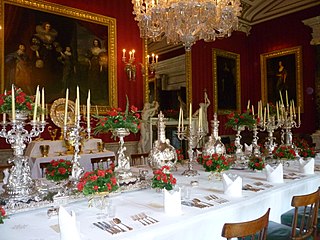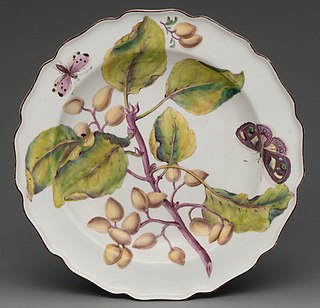Related Research Articles

Lenox Corporation is an American manufacturing company that sells tableware, giftware and collectible products under the Lenox, Dansk, Reed & Barton, and Gorham brands. For most of the 20th century, it was the most prestigious American maker of tableware, as well as making decorative pieces. Several china services were commissioned for the White House. By 2020, it was the last significant manufacturer of bone china in the United States, until the COVID-19 pandemic forced the closure of the company's only remaining American factory.
Irezumi is the Japanese word for tattoo, and refers to a distinctive style of Japanese tattooing, though it is also used as a blanket term to describe a number of tattoo styles originating in Japan, including tattooing traditions from both the Ainu people and the Ryukyuan Kingdom.

Tableware are the dishes or dishware used for setting a table, serving food and dining. It includes cutlery, glassware, serving dishes and other items for practical as well as decorative purposes. The quality, nature, variety and number of objects varies according to culture, religion, number of diners, cuisine and occasion. For example, Middle Eastern, Indian or Polynesian food culture and cuisine sometimes limits tableware to serving dishes, using bread or leaves as individual plates. Cups are not dishes. Special occasions are usually reflected in higher quality tableware.

A plate is a broad, concave, but mainly flat vessel on which food can be served. A plate can also be used for ceremonial or decorative purposes. Most plates are circular, but they may be any shape, or made of any water-resistant material. Generally plates are raised round the edges, either by a curving up, or a wider lip or raised portion. Vessels with no lip, especially if they have a more rounded profile, are likely to be considered as bowls or dishes, as are very large vessels with a plate shape. Plates are dishware, and tableware. Plates in wood, pottery and metal go back into antiquity in many cultures.

Eva Striker Zeisel was a Hungarian-born American industrial designer known for her work with ceramics, primarily from the period after she immigrated to the United States. Her forms are often abstractions of the natural world and human relationships. Work from throughout her prodigious career is included in important museum collections across the world. Zeisel declared herself a "maker of useful things."

Corning Ware, also written CorningWare, was originally a brand name for a unique glass-ceramic (Pyroceram) cookware resistant to thermal shock. It was first introduced in 1958 by Corning Glass Works in the United States. The brand was later spun off with the sale of the Corning Consumer Products Company subsidiary. Glass-ceramic based Corning Ware can be taken from the refrigerator or freezer and used directly on the stovetop, in an oven or microwave, under a broiler, for table / serving use, and when ready for cleaning put directly into a dishwasher. CorningWare is sold worldwide, and it is popular in North America, Asia, and Australia.

Mintons was a major company in Staffordshire pottery, "Europe's leading ceramic factory during the Victorian era", an independent business from 1793 to 1968. It was a leader in ceramic design, working in a number of different ceramic bodies, decorative techniques, and "a glorious pot-pourri of styles - Rococo shapes with Oriental motifs, Classical shapes with Medieval designs and Art Nouveau borders were among the many wonderful concoctions". As well as pottery vessels and sculptures, the firm was a leading manufacturer of tiles and other architectural ceramics, producing work for both the Houses of Parliament and United States Capitol.

Villeroy & Boch is a German manufacturer of ceramics, with the company headquarters located in Mettlach, Saarland.

Blue Ridge is a brand and range of American tableware (dishware) manufactured by Southern Potteries Incorporated from the 1930s until 1957. Well known in their day for their underglaze decoration and colorful patterns, Blue Ridge pieces are now popular items with collectors of antique dishware. The underglaze technique made the decorations more durable, and while basic patterns were reused consistently, the fact that each piece was hand-painted means that no two pieces are exactly alike.
The Homer Laughlin China Company is an ceramics manufacturer located in Newell, West Virginia, United States, established in 1871 and widely known or its retail dinnerware line, Fiesta. Since the late 1950s, the two brand had marketed its retail lines as well as separate lines for the food service industry. In 2010, the company acquired the nearby Hall China Company.

Black-and-gray is a style of tattooing that uses only black ink in varying shades. This tattooing style is thought to have originated from prisons in the 1970s and 1980s and was later popularized in tattoo parlors.

Blue Onion is a porcelain tableware pattern for dishware originally manufactured by Meissen porcelain since the 18th century, and since the last 19th Century has been copied by other companies.

Paul Patterson Timman is an American tattoo artist and award winning dinnerware designer. Paul's tribal designs, hand painted tattoo work in movies and celebrity clients have made him one of the "giants in the industry" called the 'Rembrandt of Sunset Strip' by the Wall Street Journal. Timman's work has been featured in tattoo magazines in the USA and internationally including: Inked (magazine), Tattoo Magazine, and Skin Art.

Bing & Grøndahl was a Danish porcelain manufacturer founded in 1853 by the sculptor Frederik Vilhelm Grøndahl and merchant brothers Meyer Hermann Bing and Jacob Herman Bing. The trademark backstamp for Bing & Grøndahl (B&G) porcelains is the three towers derived from the Coat of Arms of Copenhagen. The company's Seagull dinnerware series became known as the "National Service of Denmark" in the 1950s when it was found in one tenth of all Danish households. In 1987 the company merged with its primary competitor, the Royal Porcelain Factory under the name Royal Copenhagen.

Rörstrand porcelain was one of the most famous Swedish porcelain manufacturers, with production initially at Karlbergskanalen on the island of Kungsholmen in Stockholm.
Alyson Fox is an American artist, illustrator, and dinnerware designer. Fox was one of the first artists to gain notoriety through new media prompting The New York Times to call her "the darling of design blogs".
Dana Oldfather is an American oil painter and dinnerware designer often linked to Cleveland’s artistic resurgence.

Franciscan Ceramics are ceramic tableware and tile products produced by Gladding, McBean & Co. in Los Angeles, California, from 1934–1962, International Pipe and Ceramics (Interpace) from 1962–1979, and Wedgwood from 1979-1983. Wedgwood closed the Los Angeles plant, and moved the production of dinnerware to England in 1983. Waterford Glass Group plc purchased Wedgwood in 1986, becoming Waterford Wedgwood. KPS Capital Partners acquired all of the holdings of Waterford Wedgwood in 2009. The Franciscan brand became part of a group of companies known as WWRD, an acronym for "Wedgwood Waterford Royal Doulton." WWRD continues to produce the Franciscan patterns Desert Rose and Apple.

Vernon Kilns was an American ceramic company in Vernon, California. In July 1931, Faye G. Bennison purchased the former Poxon China pottery renaming the company Vernon Kilns. Poxon China was located at 2300 East 52nd Street. Vernon produced ceramic tableware, art ware, giftware, and figurines. The company closed its doors in 1958.

Restaurant ware, or most commonly hotelware is vitrified, ceramic tableware which exhibits high mechanical strength and is produced for use in hotels and restaurants. Tableware used in railway dining cars, passenger ships and airlines are also included in this category.
References
- ↑ Whitney Matheson (2010-05-17). "Ceramics company brings indie artists to dinner". USA Today. Retrieved 2010-05-17.
- ↑ "Ink Dish Irezumi Dinnerware Set". Prick Magazine. Archived from the original on 2009-07-08. Retrieved 2009-07-04.
- ↑ Binkley, Christina "The Rembrandt of Sunset Strip", Wall Street Journal , 2011-04-23. Retrieved on 2011-08-17.
- ↑ Barbara Thornburg (2009-05-28). "Paul Timman gives dishware a tattoo makeover". Los Angeles Times. Retrieved 2009-06-25.
- ↑ "Design 100". Metropolitan Home. Retrieved 2009-06-25.
- ↑ Brown, Phaedra "Design Firm Turns Dinnerware Into Works of Art", New York Times , 2010-07-08. Retrieved on 2010-07-08.
- ↑ Grace Bonney (2010-01-13). "New Alyson Fox Dishware". Design Sponge. Archived from the original on 2010-01-18. Retrieved 2010-03-26.